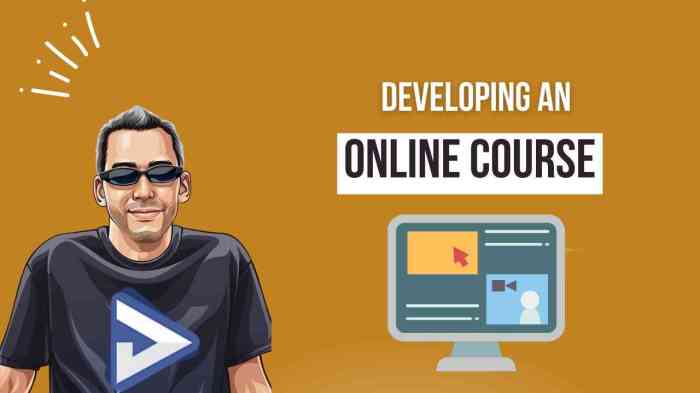Yo, check it out – we’re diving deep into the world of Developing Online Courses. Get ready for a ride filled with tips, tricks, and everything you need to know to create courses that keep students coming back for more.
From defining online courses to designing interactive activities, we’ve got you covered every step of the way. So, grab your virtual pencils and let’s get started!
Overview of Developing Online Courses

Online courses refer to educational programs delivered over the internet, allowing learners to access content remotely.
Creating engaging online courses is crucial to keep learners motivated and interested in the material being presented.
Developing online courses offers benefits such as flexibility, accessibility, and the ability to cater to diverse learning styles.
Key components of a well-developed online course include clear learning objectives, interactive content, engaging multimedia, assessments, and feedback mechanisms.
Planning Online Course Content

When it comes to planning online course content, you gotta be strategic and organized. Here are some key strategies and tips to help you Artikel objectives, organize materials, create engaging multimedia, and align content with learning outcomes.
Outlining Course Objectives, Developing Online Courses
To kick things off, outlining course objectives is crucial for setting the tone and direction of your online course. Clearly define what you want your students to achieve by the end of the course. Break down objectives into specific, measurable, achievable, relevant, and time-bound (SMART) goals to keep things on track.
Organizing Course Materials Effectively
Organizing your course materials is key to keeping your students engaged and on track. Create a clear and logical structure for your content, breaking it down into modules, lessons, and activities. Use headings, subheadings, bullet points, and numbering to help students navigate through the material easily.
Creating Engaging Multimedia Content
When it comes to creating engaging multimedia content, think outside the box. Incorporate a variety of multimedia elements such as videos, animations, infographics, and interactive quizzes to cater to different learning styles. Keep things visually appealing, interactive, and relevant to enhance the overall learning experience.
Aligning Course Content with Learning Outcomes
Aligning your course content with learning outcomes is essential for ensuring that your students are meeting the intended goals. Regularly assess how well your content is helping students achieve the desired learning outcomes. Make adjustments as needed to keep the content aligned with the overall course objectives.
Designing Engaging Learning Activities: Developing Online Courses
When it comes to online courses, designing engaging learning activities is crucial for keeping students motivated and enhancing their learning experience. Interactive activities help students stay focused, understand concepts better, and apply their knowledge in real-world situations.
Importance of Interactive Learning Activities
- Interactive activities promote active learning and engagement.
- They help students develop critical thinking and problem-solving skills.
- Interactive activities foster a sense of community and collaboration among students.
Examples of Effective Online Learning Activities
- Discussion forums where students can share their thoughts and engage in debates.
- Virtual simulations or case studies to apply theoretical knowledge in practical scenarios.
- Quizzes, polls, and interactive exercises to assess understanding and reinforce learning.
Incorporating Real-World Applications
- Use real-life examples, case studies, and projects to illustrate the practical relevance of course concepts.
- Create assignments that require students to analyze real-world problems and propose solutions.
- Encourage students to apply their learning to their own experiences or professional contexts.
Designing Assessments for Learning Outcomes
- Create a variety of assessment types, such as quizzes, essays, presentations, and group projects, to measure different aspects of learning.
- Align assessments with learning objectives to ensure they accurately reflect students’ understanding and progress.
- Provide constructive feedback on assessments to guide students in improving their knowledge and skills.
Utilizing Technology in Online Course Development
In the ever-evolving landscape of online education, utilizing technology is crucial for creating engaging and effective courses. From educational tools to learning management systems, incorporating multimedia elements and ensuring accessibility are key components of successful online course development.
Types of Educational Technology Tools
- Video lectures: Providing visual and auditory learning experiences for students.
- Interactive simulations: Engaging learners in hands-on activities to enhance understanding.
- Discussion forums: Fostering collaboration and communication among students and instructors.
- Online quizzes and assessments: Evaluating students’ knowledge and progress in real-time.
Role of Learning Management Systems (LMS)
- LMS centralizes course materials, assignments, and communication for easy access by students.
- Allows for tracking and monitoring student progress and engagement.
- Facilitates online interactions between students and instructors.
Best Practices for Integrating Multimedia Elements
- Use a variety of multimedia formats such as videos, images, and audio to cater to different learning styles.
- Ensure multimedia elements are relevant, high-quality, and enhance the learning experience.
- Provide transcripts and captions for videos to accommodate students with disabilities.
Ensuring Accessibility and Inclusivity
- Design courses with accessibility features like alt text for images and proper heading structure for screen readers.
- Provide multiple means of representation, action, expression, and engagement to accommodate diverse learners.
- Consider cultural sensitivity and inclusivity in course content and examples.